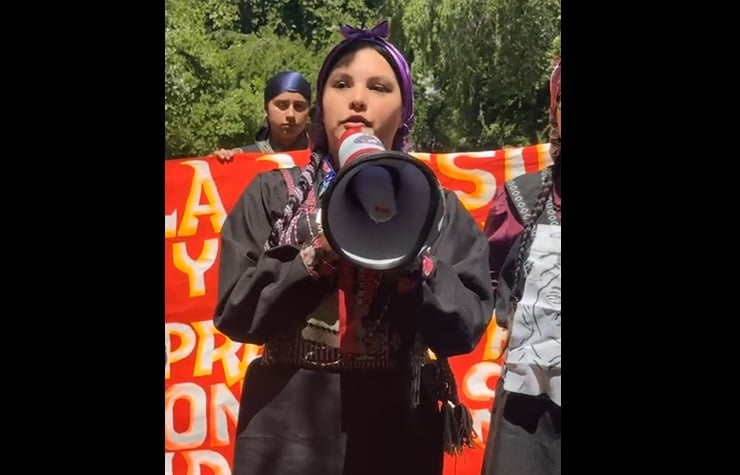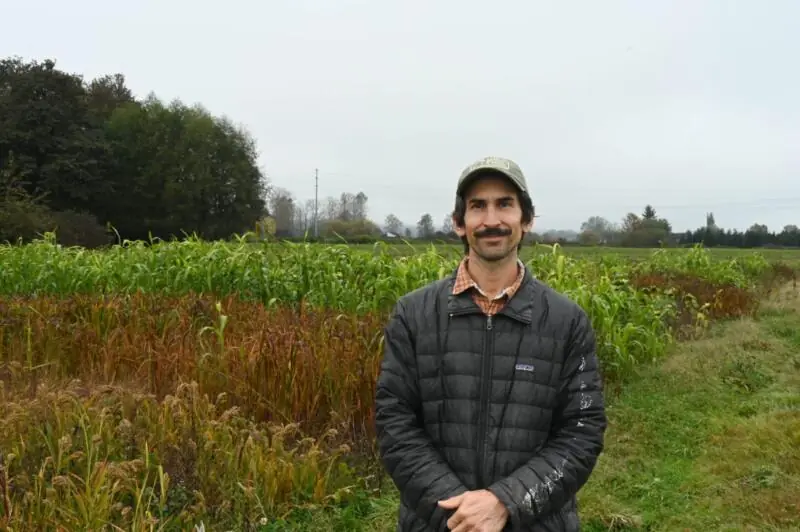One Year After the Forced Disappearance of Julia Chuñil, Her Family and Supporters Demand Justice and Remember Her Fight for Native Forests – elciudadano.com

Report on the Forced Disappearance of Julia Chuñil Catricura and its Implications for Sustainable Development Goals
Executive Summary
One year after the forced disappearance of Mapuche leader and land defender Julia Chuñil Catricura, her case continues to highlight profound challenges to the achievement of the Sustainable Development Goals (SDGs) in Chile. The incident underscores the critical intersection of environmental protection, indigenous rights, and the rule of law. This report analyzes the circumstances of her disappearance, the subsequent demands for justice, and the direct links to SDG 16 (Peace, Justice and Strong Institutions), SDG 15 (Life on Land), SDG 10 (Reduced Inequalities), and SDG 5 (Gender Equality).
Case Background: The Defense of Ancestral Lands and Ecosystems
Julia Chuñil Catricura was a prominent defender of a native forest spanning nearly one thousand hectares. This territory is of significant ecological value, containing approximately 90% floral and faunal diversity, including medicinal plants and various animal species. Her efforts to protect this ecosystem, a direct contribution to SDG 15 (Life on Land), brought her into direct conflict with commercial interests, notably businessman Juan Carlos Morstadt Anwandter. According to testimony from her family, Ms. Chuñil was subjected to threats and harassment prior to her disappearance on November 9th of the preceding year. Her granddaughter, Lissette Sánchez, has publicly identified the business interests as the primary source of this intimidation, driven by a desire to control the native forest.
Implications for the Sustainable Development Goals (SDGs)
The case of Julia Chuñil Catricura is a stark illustration of the interconnected nature of the SDGs and the severe consequences when their principles are violated. Key goals impacted include:
- SDG 16: Peace, Justice and Strong Institutions: The family’s year-long struggle for truth and justice highlights significant institutional failures. Their experience includes an initially fruitless official search, alleged media criminalization of the victim’s family, and procedural delays in the justice system, such as the last-minute cancellation of a court hearing. These events undermine public trust and challenge the commitment to ensuring equal access to justice for all, particularly for indigenous communities.
- SDG 15: Life on Land: Ms. Chuñil was an environmental human rights defender whose work was essential for halting biodiversity loss and protecting terrestrial ecosystems. Her disappearance represents an attack not only on an individual but on the collective effort to preserve vital natural habitats. The continued fight by her family to protect the forest is a testament to the ongoing importance of this goal.
- SDG 10: Reduced Inequalities: The family asserts they have faced injustice “simply for being Mapuche.” This perception points to systemic discrimination and the marginalization of indigenous peoples. The case exemplifies the heightened vulnerability of indigenous communities in land disputes and their struggle for recognition and protection of their rights over ancestral territories.
- SDG 5: Gender Equality: As a female community leader, Julia Chuñil’s case is emblematic of the specific dangers faced by women environmental defenders. The violence against women activists is a significant barrier to achieving gender equality and empowering women to participate fully in public life. Her legacy inspires other women to continue the struggle, as articulated by her granddaughter.
Legal Proceedings and Institutional Response
The path to justice for the Chuñil family has been fraught with obstacles, reflecting challenges to the efficacy of institutional mechanisms as outlined in SDG 16.
- Initial Search and Mobilization: Following an official search that was ultimately withdrawn, the family turned to social media to raise awareness and mobilize public support.
- Media Portrayal: Lissette Sánchez reported that national media outlets engaged in “mocking press,” publicly identifying and criminalizing her uncles, thereby re-victimizing the family.
- Judicial Delays: The first scheduled court hearing in the case was suspended minutes before it was set to begin, as the accused businessman, Juan Carlos Morstadt, failed to appear.
- Legal Progress: A significant development occurred on the anniversary of the disappearance, when the Los Ríos Prosecutor’s Office formally implicated Mr. Morstadt in the case. The family attributes this progress to sustained public and community pressure.
Conclusion: A Legacy of Resistance and a Call for Action
The disappearance of Julia Chuñil Catricura is a profound loss of traditional wisdom and a committed defender of the earth. However, her legacy has galvanized a broader movement. The declaration by her granddaughter, “when one falls, a thousand stand up across all territories,” signifies a strengthened resolve among Mapuche and non-Mapuche communities to continue the fight for environmental protection and human rights. The family’s commitment to continue the recovery and protection of the forest is a direct action toward fulfilling the objectives of SDG 15. The collective demand, “CHEW MULEY, JULIA CHUÑIL!” (Where is Julia Chuñil?), has evolved into a timeless call for justice, accountability, and the strengthening of institutions to protect all citizens, thereby upholding the fundamental promise of the Sustainable Development Goals.
SDGs Addressed in the Article
SDG 16: Peace, Justice and Strong Institutions
- The article’s central theme is the demand for “truth and justice” for the forced disappearance of Julia Chuñil. It highlights issues of impunity, state inaction, flaws in the judicial process (suspended hearings), and the persecution of indigenous activists, which directly relate to the goal of building effective, accountable, and inclusive institutions.
SDG 15: Life on Land
- Julia Chuñil’s disappearance is directly linked to her role as a land defender “protecting a forest.” The article specifies her work in the “recovery of nearly a thousand hectares” of native forest rich in “90% floral and faunal diversity,” connecting the conflict to the conservation and protection of terrestrial ecosystems.
SDG 10: Reduced Inequalities
- The article frames the conflict as an injustice experienced “simply for being Mapuche.” It exposes the power imbalance between a wealthy businessman and an indigenous family, highlighting systemic discrimination and the marginalization of indigenous peoples in socio-environmental conflicts.
SDG 5: Gender Equality
- The victim, Julia Chuñil, was a female “Mapuche leader and land defender.” The article also mentions other women defenders like Nicolasa Quintremán, Macarena Valdés, and Emilia Bau, pointing to a pattern of violence against women who take on leadership roles in environmental and land rights struggles. Her case is an example of the specific threats faced by women activists.
Specific SDG Targets Identified
SDG 16: Peace, Justice and Strong Institutions
- Target 16.1: Significantly reduce all forms of violence and related death rates everywhere. The article discusses the “forced disappearance” of Julia Chuñil, the “threats, harassment” she received, and the murder of her animals, all of which are forms of extreme violence.
- Target 16.3: Promote the rule of law at the national and international levels and ensure equal access to justice for all. The family’s demand for “truth and justice,” the initial suspension of a court hearing, and the eventual implication of the businessman as a suspect are all directly related to the struggle for access to and functioning of the justice system.
- Target 16.10: Ensure public access to information and protect fundamental freedoms. The article mentions the granddaughter’s use of social media to counter the “mocking press” and “media criminalization,” highlighting a struggle over public information. The persecution of a land defender is an attack on fundamental freedoms.
SDG 15: Life on Land
- Target 15.1: Ensure the conservation, restoration and sustainable use of terrestrial and inland freshwater ecosystems and their services, in particular forests. The article states Julia was “protecting a forest” and involved in the “recovery of nearly a thousand hectares.” Her family vows to “continue the recovery and protection of the forest.”
- Target 15.5: Take urgent and significant action to reduce the degradation of natural habitats, halt the loss of biodiversity. The forest being defended is described as containing “90% floral and faunal diversity,” making its protection a direct action against biodiversity loss.
SDG 10: Reduced Inequalities
- Target 10.2: Empower and promote the social, economic and political inclusion of all, irrespective of race, ethnicity, or other status. The article highlights the discrimination faced by the family “simply for being Mapuche,” indicating a lack of inclusion and protection for indigenous peoples.
- Target 10.3: Ensure equal opportunity and reduce inequalities of outcome. The difficulties the family faces in the justice system against a powerful businessman illustrate a clear inequality of outcome and opportunity within the legal framework.
SDG 5: Gender Equality
- Target 5.2: Eliminate all forms of violence against all women and girls. The “forced disappearance” of Julia Chuñil is an extreme act of violence against a woman.
- Target 5.5: Ensure women’s full and effective participation and equal opportunities for leadership. Julia was a “Mapuche leader.” The violence against her and other women defenders mentioned is a direct attack on women’s leadership in public life, particularly in environmental defense.
Indicators for Measuring Progress
SDG 16: Peace, Justice and Strong Institutions
- Qualitative Indicator: The family’s and community’s perception of justice, reflected in statements like “the injustice we were experiencing” and the demand “CHEW MULEY, JULIA CHUÑIL!” (Where is Julia Chuñil?).
- Quantitative Indicator: The number of unresolved cases of violence against land defenders. The article explicitly names four victims (Julia Chuñil, Nicolasa Quintremán, Macarena Valdés, Emilia Bau).
- Process Indicator: The status of the legal case. The article notes a negative indicator (a hearing was “canceled ten minutes beforehand”) and a positive one (“it was confirmed that this businessman is now implicated”).
SDG 15: Life on Land
- Quantitative Indicator: The area of land under conservation efforts, specified in the article as “nearly a thousand hectares.”
- Quantitative Indicator: The level of biodiversity in the protected area, mentioned as “90% floral and faunal diversity.”
SDG 10: Reduced Inequalities
- Qualitative Indicator: Reports of discrimination based on ethnicity, as stated by the granddaughter who felt the family suffered injustice “simply for being Mapuche.”
SDG 5: Gender Equality
- Quantitative Indicator: The number of women environmental and human rights defenders who are victims of violence. The article provides a specific list of four women, indicating a pattern.
Summary Table of SDGs, Targets, and Indicators
| SDGs | Targets | Indicators Identified in the Article |
|---|---|---|
| SDG 16: Peace, Justice and Strong Institutions | 16.1: Reduce all forms of violence. 16.3: Promote the rule of law and ensure equal access to justice. |
The case of forced disappearance of Julia Chuñil; mention of threats and harassment; progress in the legal case (hearing suspended, then suspect implicated); number of unresolved cases of other defenders mentioned. |
| SDG 15: Life on Land | 15.1: Ensure the conservation and restoration of terrestrial ecosystems, especially forests. 15.5: Halt the loss of biodiversity. |
The “recovery of nearly a thousand hectares” of native forest; the protection of a forest with “90% floral and faunal diversity.” |
| SDG 10: Reduced Inequalities | 10.2: Promote social, economic and political inclusion of all. 10.3: Ensure equal opportunity and reduce inequalities of outcome. |
The statement of experiencing injustice “simply for being Mapuche”; the described power imbalance between the indigenous family and the businessman in the conflict and legal process. |
| SDG 5: Gender Equality | 5.2: Eliminate all forms of violence against all women. 5.5: Ensure women’s full participation and equal opportunities for leadership. |
The forced disappearance of a female “Mapuche leader”; the list of other women defenders (Nicolasa Quintremán, Macarena Valdés, Emilia Bau) whose cases remain unsolved. |
Source: elciudadano.com
What is Your Reaction?
 Like
0
Like
0
 Dislike
0
Dislike
0
 Love
0
Love
0
 Funny
0
Funny
0
 Angry
0
Angry
0
 Sad
0
Sad
0
 Wow
0
Wow
0















































/environment-climate-change-and-health-(ech)/water-sanitation-hygiene-and-health-(wsh)/landfill-tuvalu-36092.tmb-1200v.jpg?sfvrsn=5c21fe40_1#)


.jpg.webp?itok=0ZsAnae9#)


























